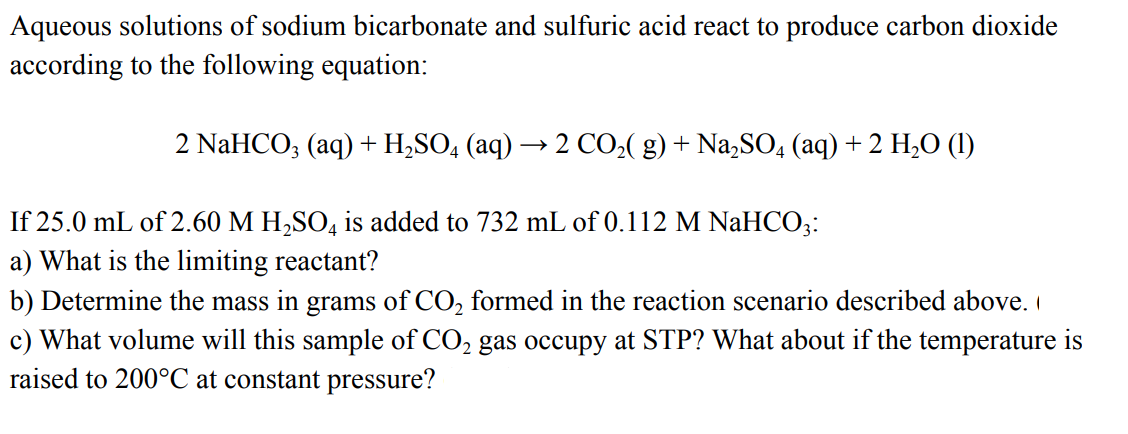Aqueous solutions of sodium bicarbonate and sulfuric acid react to produce carbon dioxide according to the following equation: 2 NaHCO; (aq) + H,SO4 (aq) → 2 CO2( g) + Na,SO4 (aq) + 2 H,O (1) If 25.0 mL of 2.60 M H,SO, is added to 732 mL of 0.112 M NaHCO;: a) What is the limiting reactant? b) Determine the mass in grams of CO, formed in the reaction scenario described above. c) What volume will this sample of CO, gas occupy at STP? What about if the temperature is raised to 200°C at constant pressure?
Aqueous solutions of sodium bicarbonate and sulfuric acid react to produce carbon dioxide according to the following equation: 2 NaHCO; (aq) + H,SO4 (aq) → 2 CO2( g) + Na,SO4 (aq) + 2 H,O (1) If 25.0 mL of 2.60 M H,SO, is added to 732 mL of 0.112 M NaHCO;: a) What is the limiting reactant? b) Determine the mass in grams of CO, formed in the reaction scenario described above. c) What volume will this sample of CO, gas occupy at STP? What about if the temperature is raised to 200°C at constant pressure?
Chemistry: Principles and Practice
3rd Edition
ISBN:9780534420123
Author:Daniel L. Reger, Scott R. Goode, David W. Ball, Edward Mercer
Publisher:Daniel L. Reger, Scott R. Goode, David W. Ball, Edward Mercer
Chapter4: Chemical Reactions In Solution
Section: Chapter Questions
Problem 4.55QE: The substance KSCN is frequently used to test for iron in solution, because a distinctive red color...
Related questions
Question

Transcribed Image Text:Aqueous solutions of sodium bicarbonate and sulfuric acid react to produce carbon dioxide
according to the following equation:
2 NaHCO; (aq) + H,SO, (aq) → 2 CO2( g) + Na,SO, (aq) + 2 H,O (1)
If 25.0 mL of 2.60 M H,SO, is added to 732 mL of 0.112 M NaHCO;:
a) What is the limiting reactant?
b) Determine the mass in grams of CO, formed in the reaction scenario described above.
c) What volume will this sample of CO, gas occupy at STP? What about if the temperature is
raised to 200°C at constant pressure?
Expert Solution
This question has been solved!
Explore an expertly crafted, step-by-step solution for a thorough understanding of key concepts.
This is a popular solution!
Trending now
This is a popular solution!
Step by step
Solved in 7 steps

Knowledge Booster
Learn more about
Need a deep-dive on the concept behind this application? Look no further. Learn more about this topic, chemistry and related others by exploring similar questions and additional content below.Recommended textbooks for you

Chemistry: Principles and Practice
Chemistry
ISBN:
9780534420123
Author:
Daniel L. Reger, Scott R. Goode, David W. Ball, Edward Mercer
Publisher:
Cengage Learning

Chemistry
Chemistry
ISBN:
9781305957404
Author:
Steven S. Zumdahl, Susan A. Zumdahl, Donald J. DeCoste
Publisher:
Cengage Learning

Chemistry: An Atoms First Approach
Chemistry
ISBN:
9781305079243
Author:
Steven S. Zumdahl, Susan A. Zumdahl
Publisher:
Cengage Learning

Chemistry: Principles and Practice
Chemistry
ISBN:
9780534420123
Author:
Daniel L. Reger, Scott R. Goode, David W. Ball, Edward Mercer
Publisher:
Cengage Learning

Chemistry
Chemistry
ISBN:
9781305957404
Author:
Steven S. Zumdahl, Susan A. Zumdahl, Donald J. DeCoste
Publisher:
Cengage Learning

Chemistry: An Atoms First Approach
Chemistry
ISBN:
9781305079243
Author:
Steven S. Zumdahl, Susan A. Zumdahl
Publisher:
Cengage Learning


Chemistry: Principles and Reactions
Chemistry
ISBN:
9781305079373
Author:
William L. Masterton, Cecile N. Hurley
Publisher:
Cengage Learning

Chemistry: The Molecular Science
Chemistry
ISBN:
9781285199047
Author:
John W. Moore, Conrad L. Stanitski
Publisher:
Cengage Learning